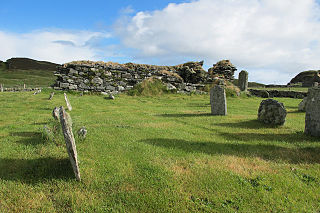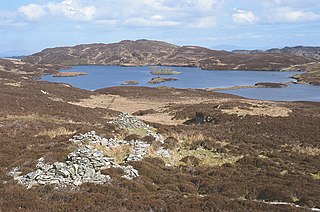 W
WColonsay is an island in the Inner Hebrides of Scotland, located north of Islay and south of Mull. The ancestral home of Clan Macfie and the Colonsay branch of Clan MacNeil, it is in the council area of Argyll and Bute and has an area of 4,074 hectares. Aligned on a south-west to north-east axis, it measures 8 miles in length and reaches 3 mi (5 km) at its widest point.
 W
WSt Cathan's Chapel is a ruined chapel on the island of Colonsay, Scotland in the Inner Hebrides. It was dedicated to Cathan, an obscure saint once venerated across the western Scottish islands. It is located at grid reference NR3629095026, in the settlement of Lower Kilchattan.
 W
WThe Colonsay Group is an estimated 5,000 m thick sequence of mildly metamorphosed Neoproterozoic sedimentary rocks that outcrop on the islands of Colonsay, Islay and Oronsay and the surrounding seabed. They have been correlated with the Grampian Group, the oldest part of the Dalradian Supergroup.
 W
WColonsay House is a Georgian country house on the island of Colonsay, in the Scottish Inner Hebrides. It is a Category B listed building, and is now in the ownership of the Barons Strathcona. The gardens are open to the public, and are listed on the Inventory of Gardens and Designed Landscapes in Scotland, the national listing of historic gardens.
 W
WDùn Eibhinn, also known as Dun Evan, Dun Eivan or Fort of Eyvind, is a hillfort located on the Inner Hebridean island of Colonsay, Scotland. The site is located at grid reference NR38209437.
 W
WKintyre and the Islands is one of the eleven wards used to elect members of the Argyll and Bute Council. It elects three Councillors.
 W
WLoch an Sgoltaire is an impounding reservoir located on the Inner Hebridean island of Colonsay, Scotland. It is located at grid reference NR386972, northwest of Kiloran and is the main source of fresh water for the island. The concrete dam was constructed in 1982 and is 3.1 metres high.
 W
WLoch Fada is a loch located on the Inner Hebridean island of Colonsay, Scotland. It extends between Kiloran and Lower Kilchattan approximately 3 km (1.9 mi) and is the largest loch on Colonsay. It is located at grid reference NR385955
 W
WThe Riasg Buidhe Cross is a cross standing in the gardens of Colonsay House on the Inner Hebridean island of Colonsay, Scotland. It takes its name from the now abandoned and ruined village of Riasg Buidhe about 1.5 miles to the south-east of Colonsay House, where it was found in the nineteenth century.
 W
WScalasaig lies on the east coast of Colonsay in the Hebrides of Scotland. It is the main settlement on the island and home to its only port; thus tourists, who come by ferry, must pass through it on the way to any part of the isle. It contains the island's shop and post office, parish church, microbrewery, doctor's surgery, village hall, cafe and hotel/bar.